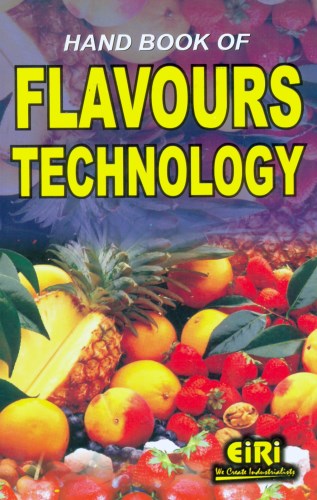Description
HAND BOOK OF FLAVOURS TECHNOLOGY
FLAVOUR ANALYSIS
- Sample Preparation
- Isolation of Food Flavours
- Headspace Methods
- Direct Injection
- Headspace Concentration
- Cryogenic Trapping
- Adsorbent Trapping
- Isolation of Flavours by Distillation Methods
- Isolation of Flavours by Solvent Extraction
- Equipment and Procedures
- Solvent Selection
- Solvent Impurities
- Solvent Extraction of Fatty Foods
- Isolation of Individual Classes of Volatile Flavours
- Sulfur Compounds
- Acids
- Alcohols
- Carbonyls
- Evaporation
- Freeze Concentration
- Adsorption
- Flavour Analysis by Direct Injection
- Gas Chromatography
- Fractionation of Flavour Isolates
- Gas Chromatography of Flavour Concentrates
- Capillary Column GC
- Chiral Gas Chromatography
- GC Detectors
- Quantification
- High Pressure Liquid Chromatography
- Identification of Volatile Flavours
- Summary
CHEMISTRY OF FLAVOURS
- Introduction
- Flavour Classification
- Flavour Formation in Plants
- Biogenesis of Fruits Aroma
- Flavours from Fatty Acid Metabolism
- Flavours Formed from Carbohydrate Metabolism
- Flavour Formation in Vegetables
- Flavour Formation from Cysteine Sulfoxide Derivatives
- Flavour formation from Gluconsinolates
- Additional Pathways for Vegetable Flavour Formation
- Location of Flavour in Plant
- Influence of Genetics, Nutrition Environment, Maturity and Storage on Flavour
- Conclusions
- Chemistry of Essential Oils
- Terpenes
- Oxygenated erpenoid Compounds
- Benzenoid Compounds
- Compounds Containing Nitrogen and Sulfur
- Nitrogen Compounds
- Sulfur compounds
- Sulfur Containing Oils
- White Mustard
- Black (Brown) Mustard
- Fruit Flavours
- Aromatic Components
- Fruit Sugars and Acids
- Sugars
- Monosaccharides
- Disaccharides
- Trisaccharides
- Nonsugars (Polysaccharides)
- Flavour of Dairy Products
- Milk
- Cheese
- Flavour Development
- Fatty Acids
- Carbonyls
- Sulfur Compounds
- Amino Acids and Peptides
- Flavour Balance
- Roquefort (Blue) Cheese Flavour
- Flavour Development
- Fermentation
- Fungi
- Black Tea Aroma
- Flavour Formation During Thermal Processing
- Nonenzymatic Browing
- General Overview of Maillard Browing
- Factors influencing Browning Rate
- Temperature
- pH
- Water Activity
- Influence of Fat
- Summary
- Formation of Flavour Comounds
- Flavours from Lipids
- Hydrolytic Reactions
- Oxidation
- Pyrolysis Reactions
- Effect of Frying Condition on Flavour
- Mechanisms of Flavour Formation
- Lactones
- Seafood Flaovurs
- Caramelization
- Flavours Formed Via Fermentation
- Esters
- Acids
- Carbonyis
- Alcohols
- Terpenes
- Lactones
- Pyrazines
- Conclusions
OFF FLAVOURS IN FOODS
- Environmental Contamination
- Waterborne Sources
- Off Flavours Due to In-Plant Water Contamination
- Tainting of Aquatic Animals by Contaminated Water
- Disinfectants, Pesticides and Detergents
- Packaging Sources
- Food Contamination
- Flavour Scalping
- Packaging Catalyzed Off Flavours
- Oxygen/Wate Vapour Transmission
- Off Flavours Due to Genetics or Diet
- Off Flavours Due to Chemical Changes in the Food
- Nonenzymatic Browning
- Photo Induced Off Flavours
- Milk
- Beer and Champagne
- Enzymatic Flavour Changes
- Lipoxygenase
- Lipase
- Proteolytic Enzymes
- Microbial Off Flavours
- Summary
MANUFACTURING PROCESSES OF FLAVOURS
- Introduction
- The Thermally Processed Flavours (Meat and Savory Flavours)
- Yeast and Autolyzed Yeast Extracts
- Basic Process Flavourings
- Complex Process Flavourings
- The Final Flavour
- Enzyme Modification and Fermentation The Dairy Flavours
- Milk and Cream Flavours
- Cultured Dairy Flavours
- Butter Flavour
- Cheese Flavours
- Creation of Dairy Flavours
- Regulatory Issues
- Appendix 4.1 IOFI Guidelines for the Production and Labeling of Process Flavours
- Introduction
- Scope
- Definition
- Basic Standards of Good Manufacturing Practice
- Production of Process Flavourings
- Raw Materials for Process Flavourings
- Preparation of Process Flavourings
- Appendix Table-A4.1
- Labeling
PLANT MATERIALS USED IN FLAVOURINGS
- 172.510 Natural Flavouring Substances and Natural Substances and Natural Substances Used in Conjunction with Flavours
- 182.10 Spices and Other Natural Seasonings and Flavourings
- 182.20 Essential Oils, Oleoresins (Solvent-Free), and Natural Extractives (Including Distillates)
- 182.40 Natural Extractives (Solvent Free) Used in Conjunction with Spices, Seasonings, and Flavourings
PRINCIPAL ESSENTIAL OILS USED IN FLAVOURINGS
APPLICATION OF FLAVOURINGS IN FOOD PROCESSING
- Flavours in Foods
- Achieving Flavour Balance
- Consumer Acceptance
- Flavour Defects
- Flavour Intensification
- Flavour Suppression
- Criteria for Application of Flavourings
- Acceptability to the Consumer
- Legal Acceptability
- Nature of Product as Sold and as Consumed
- Processing Conditions
- Available Flavourings
- Processing Parameters
- Temperature and Time
- Open or Closed System
- The Mixing Sequence
- pH
- Pressure
- Contact with Air
- specific Flavouring Applications
- Meat Products
- Baked Goods and Bakey Products
- Snack Foods
- Sugar and Chocolate Confectionery
- Pickles and Sauces
- soups
- Ice Cream and Frozen Goods
- Soft Drinks
- Conclusion
QUALITY CONTROL
- Analytical Tests
- Overview of Physicohemical Tests
- Natural Plant Materials
- General Tests
- Tests of Limited Application
- Additional Specific Tests
- Essential Oils
- General Tests
- Tests of Limited Application
- Instrumental Tests
- Specific Test for Constituents
- Tests Specific for Citrus Oils
- Specific Tests and Producedures
- Oleoresins
- General Tests
- Specific Tests
- Plated or Dispersed Spices
- General Tests
- Tests of Limited Application
- synthetic Chemicals
- General Tests Liquids
- General Tests Solids
- Specific Tests for Chemical Identity and Purity Instrumental Methods
- Flavourings
- General Tests Liquid Flavourings
- General Tests Emulsions
- General Tests Encapsulated Dry Flavourings
- Vanilla Extract
- Fruit Based Products
- General Tests
- Special Tests
- Specific Gravity
- Refractive Index
- Optical Rotation
- Alcohol Content
- Residual Solvent
- Practicle Size of Emulsions
- Volatile Oil
- Surface Oil
- Moisture Content
- Gas Chromatography
- Microbiological Analysis
- Sensory Analysis
NON-ALCOHOLIC FLAVOURS
- Compounding
- Plant Economics of Non-Alcoholic Flavours
- Plant & Machinery
- Other Fixed Assets
- Fixed Capital
- Raw Materials
- Total Working Capital/Month
- Total Capital Investment
- Turn Over/Annum
FLAVOURS FRUIT (WHISKEY, VODKA, GRAPE, BUTTER SCOTCH AND RUM)
- Artificial Flavourings
- Manufacturing Process
- For Rum Flavour
- Process Flow Diagram for Rum Flavour
- Plant Economics of Fruit Flavours
- Plant and Machinery
- Other Fixed Assets
- Fixed Capital
- Raw Materials
- For Rum Flavour
- For Whiskey Flavour
- For Grape Flavour
- For Butter Scotch Flavour
- Total Woring Capital/Month
- Total Capital Investment
- Turn Over/Annum
TERPENELESS MENTHOL CRYSTALS
- Manufacturing Process Fractional Distillation of D.M.O. for Removal of Terpene
- Extraction of Menthol
- Crystallization
- Separation of the Menthol Crystals from the Dementholized Oil
- Drying of Menthol Crystals
- Yield of Menthol & Dementholized Mint Oil
- Plant Economics of Terpeneless Menthol Crystals
- Plant & Machinery
- Other Fixed Assets
- Fixed Capital
- Raw Materials
- Total Working Capital/Month
- Total Capital Investment
- Turn Over/Annum
Engineers India Research Institute (EIRI) is a renowned name in the industrial world for offering technical and financial consultancy services.
EIRI services are:
- Detailed Feasibility Reports
- New Project Identification
- Project Feasibility and Market Study
- Identification of Lucrative Industrial Project Opportunities
- Preparation of Project Profiles / Pre-Investment and Detailed Feasibility Studies,
- Market Surveys / Studies, Market Survey Cum Detailed Techno-Economic Feasibility Reports
- Project Reports in CD Roms
- Identification of Plant /Process/Machinery and Equipment, Industrial General Guidance for setting up new industrial projects.
Our most up-to-date and Technologically Advanced Industrial Project Reports, categorized with respect to Financial Outlays and Sector – wise Classification are immensely useful for :
- Existing Small or Medium Scale Industrialists facing competition from large houses
- Young Entrepreneurs dreaming to start their own industrial enterprise
- Young Graduates and Professionals wishing to begin their career
- Industrialists interested in Debottlenecking their capacities & New Product – Lines
- Large Industrial Houses pursuing Expansion, Growth and Diversification Plans





